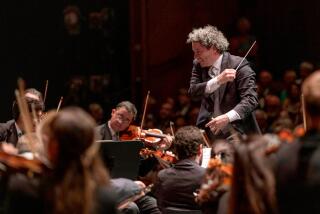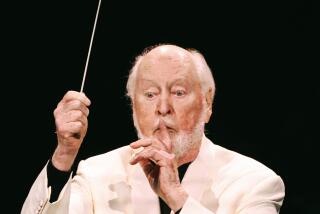Johnny Mandel has composed quite a life in music
- Share via
In 2004, the late jazz and recording session pianist Mike Melvoin spoke about his work. His storied career in the studios included playing organ on “That’s Life” for Frank Sinatra and on “Good Vibrations” for the Beach Boys, jazz piano on “Nighthawks at the Diner” by Tom Waits and many other high points. But the milestones were few and far between.
On many studio dates, musicianly camaraderie outweighed the music at hand. “When I played a Johnny Mandel date,” Melvoin clarified, “I realized: This is why I became a musician. This is why I’ve been eating hamburger for the past six months — so I can dine on Mandel’s filet mignon.”
Composer, arranger and songwriter Mandel is almost the last of a breed: the well-rounded musical omnivore who can seemingly write for any setting or purpose. His work spans the big band era (he wrote for Woody Herman and Count Basie, to name just two) and the birth of TV (he scored “Your Show of Shows” for two years). He penned nightclub material for Mae West and others, composed and arranged for Sinatra, Barbra Streisand, Michael Jackson and Natalie Cole, among many others. And, of course, his famous movie scores include such songs as “Emily,” “The Shadow of Your Smile” and the theme from “M.A.S.H.”
The 86-year-old Mandel will step away from the recording studios and his workroom to convene his orchestra at Vitello’s on Saturday. It’s a rare chance to see and hear a grand master of American music, leading a fine band through one of the most individual and varied repertoires of the last 60 years.
Mandel speaks about his music from his comfortable Malibu home, which he shares with his wife, Martha. “Everything has a law of gravity,” he explains in a customarily soft voice. “Arrangements that I don’t particularly like go from one chord to another arbitrarily. People say about music like that, ‘Oh, that’s interesting.’ I try to write something that sounds inevitable, rather than interesting.”
Mandel wrote the first jazz score for a motion picture — “I Want to Live” in 1958. In addition to scoring for studio orchestra, he integrated small-band pieces, which utilized some of the best jazz musicians extant: trumpeter Art Farmer, trombonist Frank Rosolino, baritone saxophonist Gerry Mulligan and drummer Shelly Manne. Mandel credits director Robert Wise and producer Walter Wanger for making the assignment easier than it might have been. “They were wonderful,” he asserts. “They didn’t tell me what to do. It was a lovely way to be baptized.”
John Campbell is Mandel’s regular pianist (though a prior engagement will keep him from Vitello’s). He played a tribute concert to the late composer-arranger Tiny Kahn — one of Mandel’s inspirations — a few years ago. “I came off the stage,” Campbell recounts, “and Johnny was there. He said, ‘I want you in my band.’ I was thrilled.”
His job is somewhat daunting. “It’s got to be just right,” Campbell asserts. “You always want to sound great for him. Johnny’s book is a potpourri — big-band jazz, ballads; some that are all written out. Mostly I have to play it just the way it’s written.”
Trumpeter Carl Saunders, valued for his great reading, execution and improvising skills, is a mainstay in the band. He sees Johnny’s music align with his own musical credo. “His music speaks for itself,” Saunders says. “You can forget the words and let the music wash over you. Johnny spreads beauty through music, with all those pretty chord changes and lovely melodies. That’s what drew me to music in the first place.”
Mandel’s public profile has been scant of late. A broken hip has been slow to mend, and kept him home. “I was in the hospital for four months,” Mandel divulges. “The first operation didn’t take, then they replaced the hip; I’m still learning to walk.” Pausing, he grins, “I guess I’m not as hip as I thought.”
ALSO:
New York museum taps the city’s long history of beer
Bone flutes found in German caves point to roots of creativity
Miles Davis stamp to be dedicated in NYC and at Hollywood Bowl
More to Read
The biggest entertainment stories
Get our big stories about Hollywood, film, television, music, arts, culture and more right in your inbox as soon as they publish.
You may occasionally receive promotional content from the Los Angeles Times.










